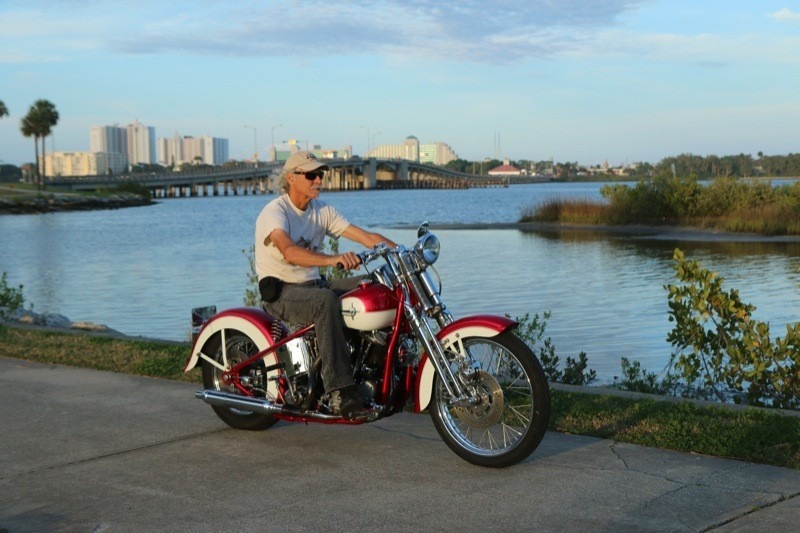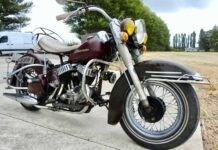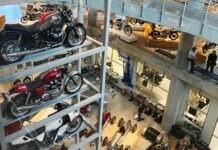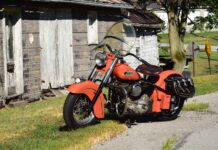The sign in front of the general store proclaimed “ALADDIN: POP 15.” We were on our way back from the Ham N Jam party, a.k.a., No Panties Wednesday, in Hulett, Wyoming, and the nearby town of Aladdin, just a few minutes from the South Dakota border, had the only fuel stop for miles around. As we killed time waiting for our turn at the lone gas pump, a tall, lanky, good-looking guy pulled up on a gorgeous Panhead, the red and white paint glistening in the hot midday sun. I had to find out more.
Dave Machesney, who lives in Pompano Beach, Florida, was the rider as well as the builder of this beautiful machine. That was back in 2003, and since then I’ve cross paths with Dave from time to time, always with his homebuilt Pan that has won numerous awards at bike shows all over the Southeast. When THUNDER PRESS was asked to perform judging duties at the Editors’ Choice Bike Show during Daytona Bike Week 2015, there was the Panhead, its glossy paint and classic beauty causing it to stand out from all the other bikes. We did due diligence and checked out each entry, but we kept going back to Dave’s Pan, which we chose as the THUNDER PRESS Editors’ Choice. For us, it was a no-brainer.

Back in early 1984, Dave was visiting his hometown of Pittsburgh when his friend Jimmy told him about an old ’52 Panhead that the owner, Tim Gould, didn’t really want to sell, but Tim did want an old pickup that belonged to Dave’s friend Mickey. Through a convoluted series of trades involving a payment plan, Dave managed to acquire the bike, which was actually in pieces stored in Tim’s dad’s garage in Erie, Pennsylvania. Dave tells me, “It was all boxes in the garage. In the middle of a blinding snowstorm I got the stuff back down to Pittsburgh and then came home to Pompano a day or two later. I saw what parts I had in the boxes, and right there in my buddy’s house, I put the motor in the frame and got a battery just to see if it ran. It started right up.”
Once Dave heard it run, he figured out what parts he needed to put it together. The first build was the exhaust, sissy bar, chopper seat, tank and all the other stuff that came in the boxes Dave hauled to Florida. There was no front end so he bought a stock ’78 Low Rider front end and fender from someone who was putting a new front end on his bike. The rear fender was just a “cheapie flat one” according to Dave. “I basically tried to build the bike with what I had, pretty much, buying minimal parts.”

Dave’s been riding motorcycles since the age of 10. “My buddy Paul and I used to ‘steal’ his brother Mike’s 350 Honda and ride it around,” he explained. Through the years he acquired an on-and-off-road Suzuki 80, as well as a Bultaco 250 and a Honda 250 Elsinore, both of which he still has. His first road bike was a 750 Honda, and the ’52 Panhead was his first build, as well as his first Harley. He planned to ride it to Daytona Bike Week the next year; 1985. He laughs, “I had all these doubters because I had built the bike myself. My buddies that had Harleys scoffed, ‘Oh, you don’t know how to build a Harley.’ The deal was if I built it myself and it started in three kicks, I’d win $100. It started on the second kick and everybody freaked out. I won the bet, but my buddy never paid me because my friend Pat helped me put the front end on it.”

He rode the bike like that for three or four years and then got a better front end that had dual-disc brakes, removed the sissy bar and chopper seat and installed a sprung seat, replaced the flat rear fender with a bobbed fender and relocated the side license plate mount so that he didn’t stab his leg every time he walked next to the bike. Dave rode that iteration of the Pan until about 2000 when he decided to redo it. His brother Rich had an aftermarket springer front end that he’d gotten from someone who owed him money and somehow Dave acquired it. He did a mockup and this time he wanted to get rid of the old peanut tank, which only had a 75-to-100-mile range. Dave said, “I wanted to use fat bob tanks and when I went to the guys—my brother’s friends—from C&H Customs in Nebo, North Carolina, they told me, ‘We don’t want any aftermarket parts because we don’t want to have to paint these tanks over again.” They wanted stock parts, so my brother found the petcock-side tank at Tilley’s Harley-Davidson in North Carolina, and I found a matching right tank in Butler, Pennsylvania, when I was there on vacation.”

Somewhere along the line Dave got a rear fender from a ’39 Knucklehead from a friend in Pompano Beach. Dave’s brother was working with the late Wyatt Fuller who was a “skunk works” designer for Harley-Davidson at the time, and Wyatt had a bunch of extra parts laying around. That’s where he got a set of 2000 Fat Boy brakes, and made them work on his bike. They found a front fender, probably from V-Twin Manufacturing, that matched the rear fender, and other parts from V-Twin include the derby cover and the primary cover, plus an OE-style oil tank.
The guys got all the components from a Harley springer front end and the guys fabricated the parts to make them work on Dave’s springer. Dave bought a headlight and found out it had different brackets so there was some fabrication involved. The spoke wheels are stock, from a 2000 Harley Low Rider, with a modern hub both front and rear to accommodate the modern brakes, which involved additional fabrication. The exhaust is a replica of a stock ’52 exhaust because, Dave noted, “It has the ‘squishy’ pipe that goes between the frame and the motor.” The transmission is also a stock ’52, and Dave says, “I’m still running a 6-volt system. Kick only. Everyone always used to give me grief, asking why I don’t change it to a 12-volt. But if it’s not broke, why am I gonna fix it?”

Dave and his brother mocked up the bike and, with the help of Jimbo and Painter at C&H, decided on the colors of the paint and the paint scheme. “The guys at C&H had an old design so that’s how I got the design on the tank. The red color is House of Kolor Brandywine over a silver base, and we also used one of the House of Kolor whites. The pin striping was painted into it before it was clear coated,” Dave explains. “They put a little ghost into the white; pearlescent, kind of; it glows the same as the red. You can only see it when the sun hits a certain way.”
After the paint was done, Dave and his brother took all the parts to Mickey’s house in Daytona Beach and put part of the bike together there, and then took it home and put it in Dave’s living room. Dave bought braided brake and oil lines and all the little things he still needed, and finished the build there, “just tinkering,” he says. “I bought parts that I took back, and I just kept trying stuff until I got it. It took me maybe three or four months.” Dave was riding the newly-rebuilt bike in time for Daytona Bike Week 2003, followed by the trip to Sturgis later that year.

Dave’s Pan joins the Bultaco and Elsinore in his garage, as well as a 1961 BMW, a 2000 Road King he acquired last year (“It’s the newest thing I own!”), and what’s left of the ’52 Pan on an old aftermarket frame. I asked him whether he has enough parts to build another Panhead, and he responded, “Yeah, pretty much. I’m debating whether I’m gonna sell it or not. Someone just called me the other day and they were interested. So I’m kind trying to figure out what it’s worth, because I don’t know if I’m ever gonna have the time to do another one. I’m still on the fence on that one.”




















Hard work and good friends.
You deserve all the accolades you get! So proud of you dude. ♡
Hey Dave ! Still have the paint on the shelf ! And without a doubt best looking pan we ever had the privilege to re- skin !
Keep in the wind !